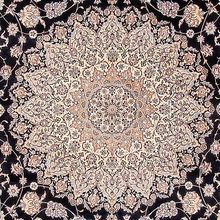Nain Rug
| Nain Rug | |
|---|---|
 Design of Nain Rug (Rugman) | |
| General information | |
| Name | Nain Rug |
| Original name | قالی نایین |
| Alternative name(s) | Nain Carpet |
| Origin | |
| Category | City |
| Technical information | |
| Common designs | Lachak Toranj, Afshan |
| Common colors | Cream, Beige, Crimson, Navy Blue, White, Blue |
| Dyeing method | Natural, Synthetic |
| Pile material | Wool, Silk |
| Foundation material | Cotton, Silk |
| Knot type | Asyemmetrical (Persian), Jufti |
Nain rugs originate from Nain, located in central Iran, just south of Isfahan. Prior to the 2nd World War, Nain was a center of fine textiles. The shift to the production of fine Persian carpets came after the war. Nain rugs are in such high demand worldwide that there are many counterfeits produced in India and Pakistan being sold as authentic. Always purchase from a reputable dealer in order to avoid disappointment. The Habibian workshop is reputed to produce the finest quality Nain rugs. These are very difficult to come by as they are woven in limited quantity. Even more rare is a signed piece. Master craftsmen weave Nain rugs using Persian knots. Experts use a different measurement called LAA, a Farsi word meaning layers, to define the quality of Nain rugs. LAA refers to the number of threads forming each fringe at the end of the carpet. The LAA number on Nain rugs is a good indicator of the price. As the LAA numbers decrease, the price proportionately increases.
History
See also
References
Bibliography
- Abraham Levi Moheban. 2015. The Encyclopedia of Antique Carpets: Twenty-Five Centuries of Weaving. NewYork: Princeton Architectural Press.